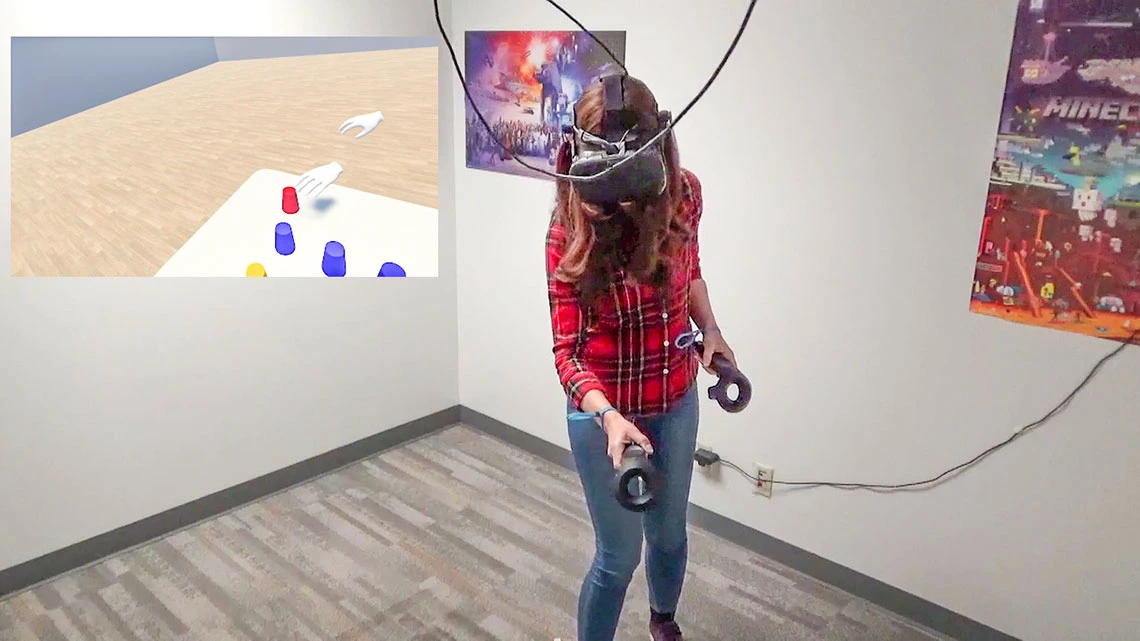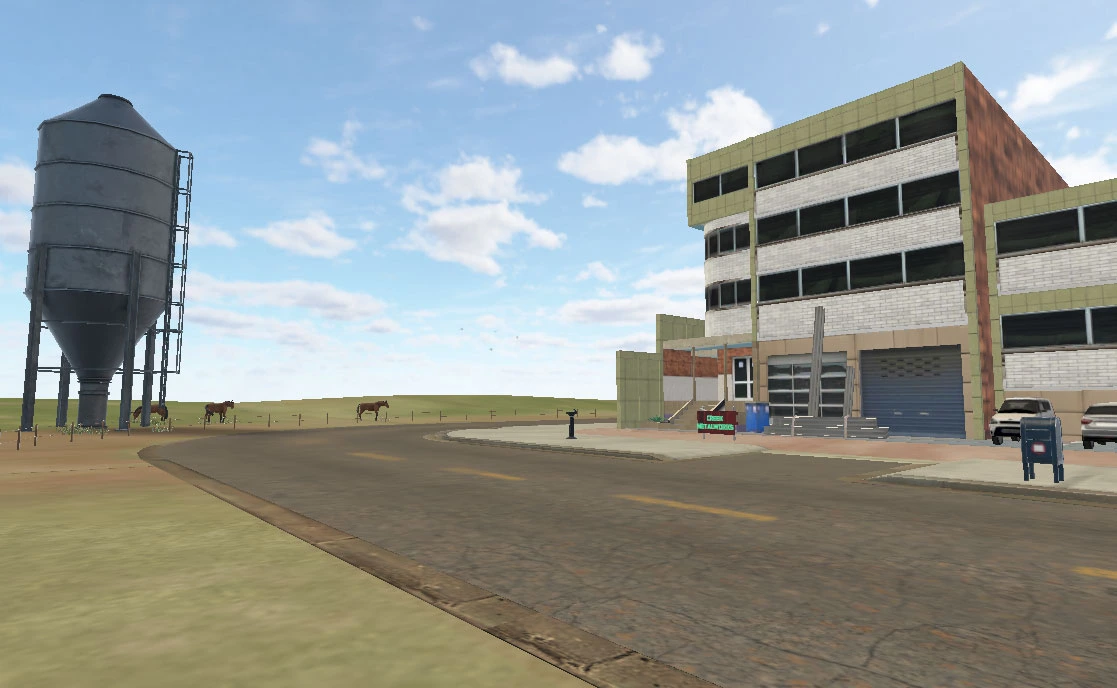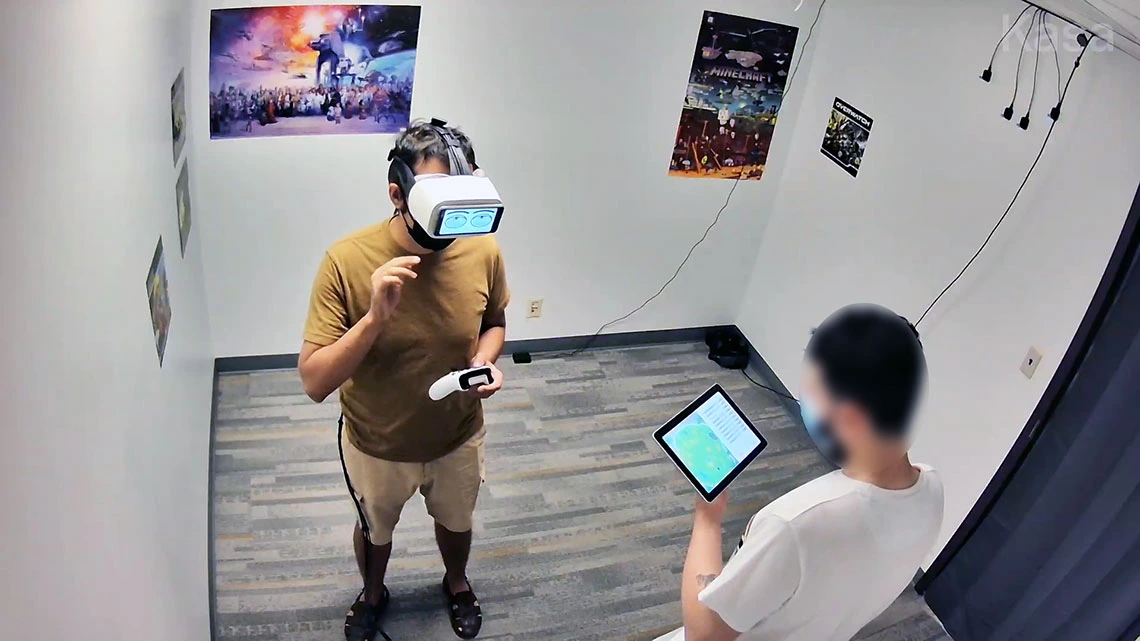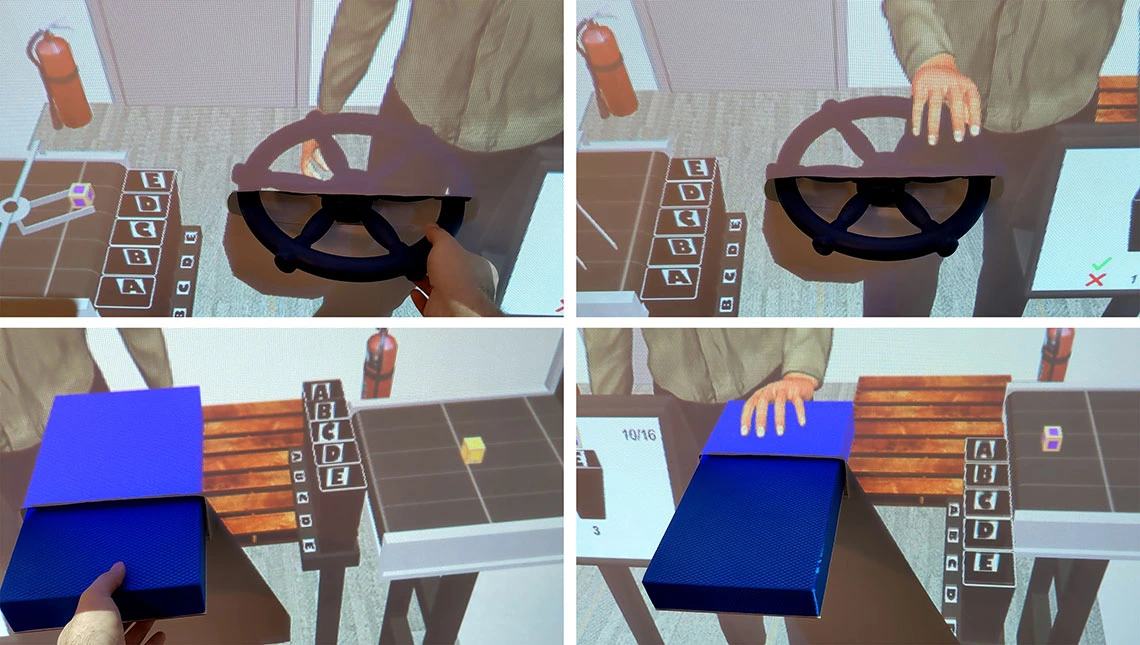The Value of Academic Extended Reality and Games Research to Industry: A Look Inside the University of Arizona XRG Lab

The Extended Reality and Games Lab (XRG Lab), led by College of Information Science professors Lila Boz and Ren Boz, conducts cutting-edge research on extended and virtual reality, including this horizontally flipped interaction in VR for improving spatial ability.
By fostering an environment where curiosity drives research and collaboration bridges disciplines, the Extended Reality and Games Lab not only advances academic knowledge but also provides valuable insights and innovations to industry.
The cutting-edge research of the University of Arizona College of Information Science (InfoSci) explores the intersections of people, data and technology. And it’s that nexus where labs such as the Extended Reality and Games Lab (XRG Lab) play a critical role for industry and, more broadly, a society undergoing rapid technological change.

Lila Boz, Assistant Professor of Information Science.
The XRG Lab is a pioneering research hub led by Assistant Professors Lila Boz and Ren Boz. Dedicated to advancing the fields of extended reality (XR) and game development through innovative research and practical applications, the lab aims to enhance user experiences, improve usability and explore the potential of XR across industries, from health, education and training to entertainment and defense.
The XRG Lab focuses on designing, developing and evaluating advanced new interaction techniques and enhanced XR experiences. The research questions driving their work include:
- Improving lives: How can XR be enhanced to improve education, health and wellbeing, training, accessibility, empathy, awareness and entertainment?
- Usability and user experience: What are the effects of novel interaction techniques on usability and user experience in XR?
- Seamless integration: How can the boundary between the real and virtual worlds be blurred to create more intuitive and immersive user experiences?
- Beneficial gaming: How can video games be leveraged to promote healthier lifestyles, increased knowledge and improved skills?

Ren Boz, Assistant Professor of Information Science.
Their research is characterized by a strong emphasis on empirical user studies, contributing to the existing knowledge in the field through peer-reviewed publications and presentations. Graduate and undergraduate students actively participate in these projects, gaining hands-on experience and contributing to the research outcomes.
Virtual Reality for Veterans with Traumatic Brain Injuries
One of the lab’s notable research projects, Virtual Cognitive Rehabilitation Using a Virtual Reality Serious Game for Veterans with a History of Traumatic Brain Injury, exemplifies the impactful work being conducted at the XRG Lab. This project, a collaboration with the University of Arizona College of Medicine - Phoenix and funded by the U.S. Department of Veterans Affairs, explores the use of virtual reality (VR) to aid cognitive rehabilitation for military veterans suffering from traumatic brain injury (TBI).
“In the U.S., approximately 1.7 million people suffer from TBI annually, with many reporting cognitive symptoms that significantly impact their lives,” says Ren Boz. “Previous research has demonstrated that exposing brain-injured rodents to novel environments can aid in cognitive rehabilitation.” Building on this foundation, the XRG Lab has developed a VR application that offers spatial navigation in various novel virtual environments, aiming to translate these findings to human rehabilitation.
The application features five virtual environments—mall, city, town, airport and junior college—each with 16 levels of increasing difficulty. Users navigate these environments to familiarize themselves and reach assigned destinations. The design prioritizes an inviting and non-threatening experience to avoid re-immersion or flashbacks for veterans.

A screenshot from the Virtual Cognitive Rehabilitation Using a Virtual Reality Serious Game for Veterans with a History of Traumatic Brain Injury research, funded by the U.S. Department of Veterans Affairs and in collaboration with the University of Arizona College of Medicine - Phoenix.
Key features of the application include:
- Gamification: Collectibles, challenge coins and a scoring system to motivate users.
- Navigation aids: Highlights and helper arrows to assist users in navigation.
- Customization: Military overtones and personal connections, such as displaying military branch flags and using familiar names for locations.
- Motion sickness mitigation: Techniques like translational vignettes and a virtual nose to reduce motion sickness.
The development of this VR application involved participatory design with four veterans serving as lived-experience consultants. Their feedback was crucial in refining the application to meet the specific needs and preferences of TBI sufferers:
- Motion sickness and locomotion: The lived-experience consultants tested various locomotion techniques. Steering only in the head’s direction minimized motion sickness. Additional measures, such as snap rotation and spatial frames of reference, further reduced discomfort, enabling longer play sessions.
- Familiar elements and signifiers: Incorporating military-related elements, such as challenge coins and non-player characters in military clothing, increased user engagement. Personal connections, like using the lived-experience consultants’ names for locations, made the experience more relatable.
- Increasing motivation: Gamification elements and reminders of the application’s potential health benefits were effective motivators. The variety in environments and upbeat background music also kept users engaged.
- Ease of mental association: Adding distinguishing features to virtual buildings helped with spatial mapping. Refining the naming conventions for locations reduced confusion and improved the user experience.
“Many novel insights were gained from the lab’s development of the VR application aimed at rehabilitation for veterans with traumatic brain injury,” says Lila Boz. “By improving spatial navigation skills, this technology not only enhances veterans’ quality of life but also offers valuable insights for employers and broader industries looking to leverage XR for training, rehabilitation and employee wellbeing.”

The Virtual Cognitive Rehabilitation Using a Virtual Reality Serious Game for Veterans with a History of Traumatic Brain Injury project aims to provide VR-based cognitive rehabilitation to individuals with a history of traumatic brain injury, or TBI.
The Role of Students
Students play a vital role in the XRG Lab’s research projects, including Virtual Reality Serious Game for Veterans with a History of Traumatic Brain Injury. Those who excel in InfoSci courses such as game development and virtual reality are given opportunities to work on these projects. Their contributions include implementation, 3D modeling and database management. Notably, information science and computer science students Arya Mayfield, Ryu Funakoshiya, Quan Le and Kyle Walker contributed significantly to the VR spatial navigation project, showcasing the lab’s commitment to integrating student learning with cutting-edge research.
The Value of Academic Research to Industry
Academic research in XR and game development holds significant value for the industry. Unlike industry-driven research, which often faces the pressures of product cycles and strict deadlines, academic research enjoys the freedom to pursue fundamental and transformative questions. This environment allows researchers to explore innovative ideas that might be deemed too risky or speculative in a commercial setting.
For instance, says, Ren Boz, “the work done at the XRG Lab on VR applications for cognitive rehabilitation can inform industry practices by providing evidence-based insights and tested prototypes.” The novel interaction techniques and usability improvements developed in academic settings like the XRG Lab can be directly applied to commercial products, enhancing their quality and user experience. Moreover, academic research often leads to the development of new tools and methods that can be adopted by the industry to streamline their processes and innovate further.
“Additionally, the interdisciplinary nature of academic research brings together diverse perspectives and expertise, fostering creativity and innovation,” he concludes. “Collaborations between academia and industry can lead to breakthroughs that neither could achieve alone. For the industry, engaging with academic research ensures access to cutting-edge developments and the opportunity to recruit highly skilled graduates who are well-versed in the latest technologies and methodologies.”

The XRG Lab has conducted research exploring the effects of displaying users' eye movements outwardly on head-mounted VR displays (goggles) to increase nonverbal communication cues toward outside users, thereby improving communication between head-mounted display users and non-users.
The Interdisciplinary Advantage of the College of Information Science
The interdisciplinary nature of the college provides a unique advantage for conducting this type of research. “By integrating diverse fields of study, the College of Information Science fosters intellectual diversity and opens up numerous collaboration opportunities” says Interim Dean Catherine Brooks. “This approach not only enriches the research but also enhances the educational experience for students, preparing them for impactful careers across industries.”
“Research at the XRG Lab exemplifies how interdisciplinary collaboration can lead to significant advancements,” says Lila Boz. “The integration of knowledge from fields such as computer science, psychology and medical science has enabled the development of innovative XR applications that address real-world problems. This collaborative spirit is crucial for pushing the boundaries of what is possible in XR and game development.”

XRG Lab research funded by the National Science Foundation explores bidirectional embodied tangible interaction between a human user and a virtual character in a world-fixed virtual reality.
Innovative Spirit and Commitment to Excellence in Research and Application
The Extended Reality and Games Lab at the College of Information Science exemplifies the transformative potential of interdisciplinary research in XR and game development. Through projects like the VR spatial navigation application for veterans with TBI, the lab is making significant contributions to both academic knowledge and practical applications that can improve lives. As the college continues its own transformation, the XRG Lab stands as a testament to the innovative spirit and commitment to excellence that defines the University of Arizona.
By fostering an environment where curiosity drives research and collaboration bridges disciplines, the XRG Lab not only advances academic knowledge but also provides valuable insights and innovations to industry. This essential relationship between academia and industry ensures that the developments in XR and game development continue to benefit society at large.
Learn more about the XRG Lab, or explore possibilities for industry partnership with the College of Information Science at the University of Arizona.

